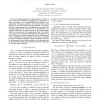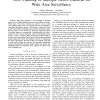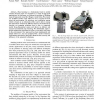ICRA
2007
IEEE
14 years 7 months ago
2007
IEEE
— This paper describes a novel experiment in which two very different methods of underwater robot localization are compared. The first method is based on a geometric approach in...
ICRA
2007
IEEE
14 years 7 months ago
2007
IEEE
— Increasing the field of view of camera is an important issue practical in robot vision. One solution is to consider catadioptric camera that allows a 360o field of view. In t...
ICRA
2007
IEEE
14 years 7 months ago
2007
IEEE
Abstract— In this paper, we study the accuracy of Cooperative Localization and Target Tracking (CLATT) in a team of mobile robots, and derive analytical upper bounds for the posi...
ICRA
2007
IEEE
14 years 7 months ago
2007
IEEE
ICRA
2007
IEEE
14 years 7 months ago
2007
IEEE
Abstract— We describe a fast method to relocalise a monocular visual SLAM (Simultaneous Localisation and Mapping) system after tracking failure. The monocular SLAM system stores ...
ICRA
2007
IEEE
14 years 7 months ago
2007
IEEE
—The current research analyses and demonstrates how spoken language can be used by human users to communicate with the HRP-2 humanoid to program the robot’s behavior in a coope...
ICRA
2007
IEEE
14 years 7 months ago
2007
IEEE
— This paper introduces a signal-recognition based approach for detecting autonomous mobile robot immobilization on outdoor terrain. The technique utilizes a support vector machi...
ICRA
2007
IEEE
14 years 7 months ago
2007
IEEE
— This paper describes a view planning of multiple cameras for tracking multiple persons for surveillance purposes. When only a few active cameras are used to cover a wide area, ...
ICRA
2007
IEEE
14 years 7 months ago
2007
IEEE
— Tracking in crowded urban areas is a daunting task. High crowdedness causes challenging data association problems. Different motion patterns from a wide variety of moving objec...
ICRA
2007
IEEE
14 years 7 months ago
2007
IEEE
— Map learning is a fundamental task in mobile robotics because maps are required for a series of high level applications. In this paper, we address the problem of building maps ...



